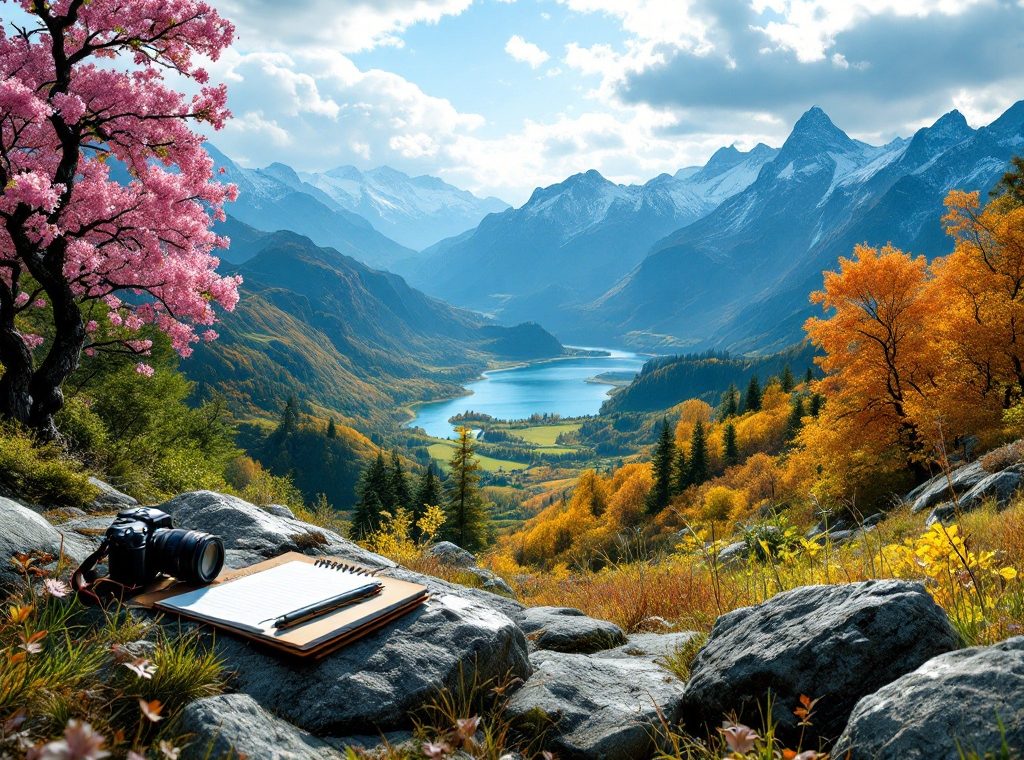Best Time to Travel to New Zealand as a Journalist
Calling all journalists! Discover the best time to unlock New Zealand’s captivating stories. Escape the crowds and capture stunning landscapes in spring and autumn, with pleasant weather ideal for interviews and exploring vibrant festivals. From summer adventures to winter sports, uncover unique angles and experience the magic of New Zealand. Plan your journalistic journey now and unearth a wealth of compelling narratives.
Important information

- Spring (Sept-Nov) and Autumn (Mar-May) offer pleasant weather, fewer crowds, and diverse story opportunities, from landscapes to local festivals.
- Summer (Dec-Feb) is peak season, ideal for outdoor activity coverage but expect higher prices and more tourists. Book well in advance.
- Winter (Jun-Aug) is best for city life and snow sports reporting, with lower accommodation costs except in ski resort towns.
- March is particularly attractive, providing warm temperatures without the summer crowds.
- Year-round events like WOMAD, Matariki, food/wine festivals, and Rugby Sevens offer unique coverage angles.
Understanding the Best Time to Travel to New Zealand as a Journalist
New Zealand’s shoulder seasons, spring (September to November) and autumn (March to May), offer journalists ideal visiting conditions. These periods boast pleasant weather and fewer tourists, alongside diverse natural landscapes. Spring explodes with colorful blooms, while autumn showcases stunning foliage. Both seasons are rich with storytelling opportunities, from captivating landscapes to local events and festivals. March is especially attractive, offering warm temperatures without the summer crowds (December to February). Visiting during these months allows journalists to experience New Zealand’s beauty with greater tranquility and access.
Optimal Seasons for Visiting New Zealand
Summer (December-March): Peak season, ideal for outdoor activities and festivals. Expect higher prices and more tourists.
Winter (June-August): Best for city breaks and snow sports.
Autumn (March-May): Pleasant weather and fewer crowds. Perfect for exploring nature and capturing stunning foliage.
Spring (September-November): Landscapes burst with life, offering beautiful scenery for hiking and vibrant food festivals.
Summer (December to March): Peak Travel Season
New Zealand summers, spanning from December to March, offer long sunny days with temperatures between 16°C and 24°C. This is peak travel season, and late December is the busiest and priciest time to visit. Plan your trip accordingly.
Autumn (March to May): Ideal for Pleasant Weather and Avoiding Crowds
New Zealand welcomes autumn in March, April, and May, bringing cooler, more pleasant weather ideal for outdoor activities. The summer crowds dissipate, making March an especially attractive time to visit. Its comfortably warm temperatures offer the perfect opportunity to discover everything New Zealand has to offer.
Winter (June to August): City Breaks and Snow Sports
New Zealand’s winter, from June to August, offers journalists exciting story possibilities. Explore vibrant city life and uncover rich cultural experiences, gaining insights into local communities. While winter brings tranquility, the South Island transforms into a hub for skiing, snowboarding, and other winter sports, attracting tourists worldwide and within New Zealand. Discover this unique side of New Zealand, witnessing the shift in tourism and experiencing the distinct winter culture.
Spring (September to November): Hiking and Festivals
New Zealand’s spring, from September to November, presents journalists with a diverse range of story opportunities. Mild weather and blossoming landscapes provide the perfect backdrop for exploring the country’s natural beauty, from hiking scenic trails to capturing the vibrant flora. Spring is also a prime time for food and wine enthusiasts, with numerous festivals showcasing local produce and culinary expertise. Consider covering the colorful Alexandra Blossom Festival, a vibrant celebration of spring’s arrival, or the Hawke’s Bay Arts Festival for a different cultural perspective.
Nature’s Resurgence
Capture the beauty of New Zealand’s landscapes in full bloom. Hike picturesque trails, document the vibrant flora, and witness the resurgence of wildlife.
Culinary Delights
Explore the diverse culinary scene through food and wine festivals. Sample local produce, experience culinary expertise, and cover events like the Alexandra Blossom Festival and Hawke’s Bay Arts Festival.
Weather and Climate Considerations
New Zealand’s varied climate significantly impacts journalists’ travel plans.
Summer (December-March)
Offers warm weather perfect for outdoor reporting, though extreme heat can sometimes be a challenge. Typical summer temperatures range from 20-30°C (68-86°F).
Winter (June-August)
Provides opportunities for snow sports coverage, but journalists should be aware of potential road closures due to snow. Winter lows average between 0-10°C (32-50°F).
Spring (September-November)
Boasts milder temperatures, ideal for fieldwork and travel throughout the country. Spring temperatures generally range between 10-20°C (50-68°F).
Autumn (March-May)
Offers milder temperatures, ideal for fieldwork and travel throughout the country. Autumn temperatures generally range between 10-20°C (50-68°F).
Rainfall is a year-round occurrence, particularly in the western regions. Packing layers is essential for journalists to comfortably adapt to fluctuating conditions. Rapid weather changes, especially in Fiordland, necessitate preparedness and adaptability.
Average Temperatures and Weather Conditions by Season
Summer (December – February): Warm temperatures prevail, averaging between 20°C and 30°C.
Autumn (March – May): Cooler weather arrives, generally ranging from 10°C to 20°C.
Winter (June – August): The coldest season, with temperatures often between 0°C and 10°C. Mountainous regions frequently experience snowfall.
Spring (September – November): Temperatures gradually increase, typically ranging from 10°C to 20°C.
Travel Costs and Accommodation Insights
Planning your trip to New Zealand? Be aware that costs can vary significantly depending on the season. Summer (December-February) is peak season, resulting in higher prices for flights and accommodation. Booking well in advance is highly recommended. For pleasant weather combined with lower costs, consider visiting during spring or autumn. If budget is your top priority, winter (June-August) offers the best deals on accommodation, except in popular ski resort towns like Queenstown and Wanaka. Always consider weather conditions and any special events happening during your planned travel dates. New Zealand offers diverse accommodation options, ranging from budget-friendly hostels and campsites to luxurious lodges. Utilize online booking platforms and tourism websites to find the perfect match for your New Zealand adventure.
Impact of Peak Season on Travel Costs
Planning a December trip to New Zealand? Be prepared for peak season prices, especially towards the end of the month. High demand increases the cost of flights and accommodation, so budget accordingly. If your dates are flexible, consider visiting in November or March. These shoulder seasons offer pleasant weather, fewer crowds, and better deals on accommodations and tours. Plus, you’ll have an easier time booking your preferred activities.
Accommodation Availability and Booking Tips
Planning your peak season escape? Booking your accommodations ahead of time, especially for summer trips, helps you lock in better rates and snag your ideal place to stay.
Events and Festivals to Cover as a Journalist
Experience New Zealand’s vibrant events all year round. For food and wine lovers, Marlborough offers a plethora of culinary festivals, including the famous Marlborough Wine & Food Festival. Pinot Noir enthusiasts should not miss Toast Martinborough, a celebration of this signature grape.
Music and Culture
Immerse yourself in the vibrant music and culture scene. WOMAD, the World of Music, Arts and Dance, electrifies New Zealand with global rhythms and artistic expression. Celebrate Matariki, the Māori New Year, and experience rich cultural traditions and festivities.
Sports and Culinary Delights
Sports fans can revel in the excitement of New Zealand’s Rugby Sevens tournaments, attracting international crowds. For a unique culinary experience, indulge in Crayfest Kaikōura, showcasing the region’s prized crayfish.
Food and Wine Festivals: Marlborough and Toast Martinborough
Marlborough hosts the Marlborough Food and Wine Festival, showcasing the region’s renowned Sauvignon Blanc.
This festival offers journalists prime opportunities to explore local wineries, sample diverse cuisine, and interview winemakers and chefs.
Toast Martinborough is a similar event that celebrates Martinborough’s wines, particularly Pinot Noir.
This festival also provides excellent opportunities for journalists to visit local wineries, experience the culinary scene, and interview key figures in the wine and food industry.
Music and Cultural Events: WOMAD and Matariki
WOMAD, the World of Music, Arts and Dance festival, showcases extraordinary global artists in a vibrant celebration of culture. Similarly, Matariki, the Māori New Year, is a deeply significant cultural event. Both festivals offer journalists exciting opportunities to uncover unique stories. They provide a rich tapestry of human expression, encompassing music, dance, visual arts, and storytelling. Journalists can explore the diverse backgrounds of the artists, the cultural significance of the performances, and the impact of these events on local communities. The festivals also offer a chance to examine the role of arts and culture in fostering intercultural dialogue and understanding. From vibrant costumes and rhythmic beats to ancient traditions and contemporary interpretations, WOMAD and Matariki provide a wealth of compelling narratives waiting to be discovered.
Sporting Events: Rugby Sevens and Crayfest Kaikōura
The fast-paced, high-scoring action of Rugby Sevens thrills fans globally. Meanwhile, Crayfest Kaikōura, a vibrant celebration of crayfish, offers food, entertainment, and a lively atmosphere. Journalists attending these events will find rich material, from sports and culture to unique local traditions, providing compelling stories.
Practical Travel Tips and Itinerary Planning
Planning a journalism trip to New Zealand? Timing is everything. Research potential events and news stories in advance to coincide with important happenings. Consider the time of year:
Summer is vibrant, but pricey and packed.
Spring and autumn offer pleasant weather with fewer crowds.
Winter is perfect for city features or snow sports coverage.
Book accommodations and transport early, especially during peak season, but stay flexible. News is unpredictable, so be ready to adjust your itinerary.
Travel Planning and Travel Timing for Journalists
New Zealand offers journalists a wealth of story opportunities year-round. Spring (September to November) and autumn (March to May) offer the most comfortable traveling conditions with pleasant weather and fewer crowds, making story coverage and interviews easier. These seasons also feature a variety of local events and festivals. Summer (December to February) is perfect for capturing exciting stories of outdoor activities like hiking and kayaking. Winter (June to August) offers unique perspectives on winter sports and cultural experiences.
Spring (September-November) / Autumn (March-May)
- pleasant weather,
- smaller crowds,
- easier story coverage and interviews,
- vibrant local events and festivals.
Summer (December-February)
ideal for stories about outdoor adventures (e.g., hiking, kayaking).
Winter (June-August)
unique perspectives on winter sports and cultural experiences.














